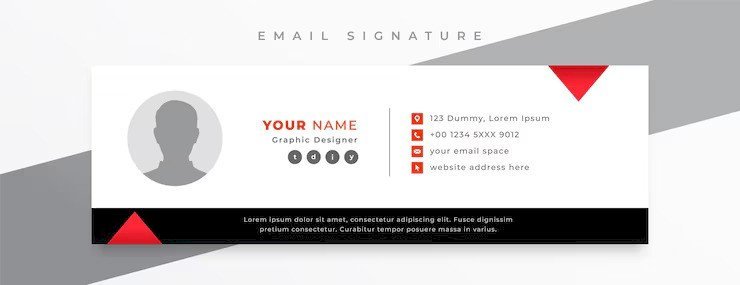How to Create a Professional Email Signature That Stands Out in 2025
Learn how to create a professional email signature in 2025 that boosts your brand, builds credibility, and makes a lasting impression. Discover essential elements, modern design tips, tools, and trends for freelancers, businesses, and teams.

In the professional world, first impressions aren’t made just in person—they begin the moment you send an email. One overlooked but powerful detail that influences how you’re perceived is your email signature. A well-designed signature doesn’t just provide contact information; it reflects your professionalism, boosts your credibility, and reinforces your personal or company brand.
In this 2025 guide, we’ll explore how to build a modern, standout email signature, what elements to include, the tools you can use, and the common mistakes to avoid. Whether you’re a freelancer, business owner, or part of a large organization, the right email signature can help you make a lasting impact every time you hit “Send.”
Why Email Signatures Still Matter in 2025
Despite the rise of messaging apps, email remains the backbone of formal communication. According to a 2025 study by McKinsey, over 91% of professionals still prefer email for business communication. That makes your signature a branding opportunity you can't afford to waste.
Here’s why it matters more than ever:
-
First Impression: It’s often the only visual part of an email conversation.
-
Professional Branding: Consistent, branded signatures strengthen recognition.
-
Easy Contact Access: Offers your recipients everything they need to reach you or learn more.
-
Built-in Marketing: You can showcase your latest work, social presence, or bookable calendar.
-
Trust & Legitimacy: A polished signature makes you look credible—especially when emailing new contacts.
Key Elements of a Great Email Signature
Not all email signatures are created equal. Some look cluttered, while others don’t display properly on mobile. Here's what a high-quality 2025 signature includes:
1. Full Name and Title
This is your digital business card. Use your full name and current role or title. Avoid nicknames unless relevant to your branding.
2. Company Name & Website
If you're representing a business, include your company name and hyperlink to the official site.
3. Email Address & Phone Number
Even though your email is visible in the "From" field, including it in your signature ensures clarity, especially when emails are forwarded.
4. Location (Optional)
Adding a city or country helps if you work internationally or schedule meetings across time zones.
5. Social Media Icons
Only include relevant and professional platforms:
-
LinkedIn: Always appropriate
-
Twitter/X: If you share professional content
-
YouTube or Instagram: If relevant to your brand or business
Make sure icons are small and consistent in color.
6. Company Logo or Profile Photo
Logos improve brand visibility, while headshots help build personal trust—especially in sales or networking roles.
7. Call to Action (CTA)
CTAs add value. Examples:
-
“Book a free consultation”
-
“Check out our latest guide”
-
“Leave a review”
8. Legal or Compliance Disclaimers (If Required)
Some industries (law, healthcare, finance) may require privacy, confidentiality, or compliance statements.
Modern Design Practices for 2025
To ensure your signature looks great across all devices and clients, follow these design tips:
| Best Practice | Why It Matters |
|---|---|
| Responsive Design | Works on mobile, desktop, and tablets |
| Horizontal Layout | Easier to read at a glance |
| Limited Colors | Keeps it professional and on-brand |
| Web-Safe Fonts | Compatible across all email clients |
| Small File Sizes | Avoids slow load times and spam filters |
| Minimal Animation | GIFs can break or be blocked in some clients |
How to Create an Email Signature (Step-by-Step)
Creating a signature doesn’t require coding or design skills anymore. Here's a beginner-friendly breakdown:
Step 1: Decide on the Goal
What do you want your signature to do?
-
Look more professional?
-
Promote your website or service?
-
Encourage bookings?
This decision will shape your layout.
Step 2: Write Out Your Details
On a notepad or doc, list:
-
Your full name and job title
-
Company name and website
-
Phone number and email address
-
Social media links (only professional ones)
-
Optional CTA or booking link
-
Legal disclaimer if required
Step 3: Choose a Visual Element
Decide if you want:
-
Just text (clean & fast)
-
Company logo
-
Profile headshot
Make sure images are properly sized (generally 100x100px or less).
Step 4: Use a Generator Tool
Skip the hassle of HTML. You can build it instantly using a Free Email Signature Generator that supports custom branding, layouts, and even copy-paste-ready HTML for Gmail, Outlook, Apple Mail, and more.
Step 5: Test Before Using
Email yourself and a colleague to check:
-
Mobile layout
-
Image loading
-
Link functionality
-
Appearance in Gmail and Outlook
Mistakes to Avoid
Avoiding these pitfalls will help you maintain professionalism and ensure deliverability:
-
Too many colors or fonts
-
Personal social media links (e.g., Facebook or TikTok unless relevant)
-
Outdated contact info or broken links
-
All-image signatures (trigger spam filters and fail to load)
-
Including too much text—keep it brief and clean
-
Using large images (slow to load or distorted)
Top Email Signature Tools in 2025
| Tool Name | Features | Ideal For |
|---|---|---|
| Reply.io Generator | Clean UI, fast HTML output, free | Professionals & small teams |
| HubSpot Generator | Drag-and-drop editor, templates | Marketers & agencies |
| WiseStamp | Paid branding options, team management | Businesses & freelancers |
| Mail-Signatures.com | Pre-built HTML layouts | Advanced users |
| MySignature | CRM integrations, live previews | Sales teams, remote workers |
Email Signature Trends to Watch in 2025
Modern signatures are evolving with changing communication preferences. Here are five growing trends:
1. Dark Mode Compatibility
Design your signature with both light and dark email themes in mind. Use transparent PNGs and check contrast levels.
2. Interactive CTAs
People want convenience. Booking links, direct downloads, or surveys embedded in your signature are on the rise.
3. Eco-Friendly Tags
Lines like “Think before printing this email” are making a comeback as businesses strive for green branding.
4. Pronoun Inclusion
Adding (she/her), (they/them) is increasingly accepted for inclusivity in workplaces.
5. QR Code Additions
Some professionals include a mini QR code linking to their LinkedIn profile or digital business card.
Conclusion
Your email signature is a quiet ambassador of your brand. In 2025, where remote work and digital-first impressions dominate, it can either elevate your image—or diminish it.
Luckily, you don’t need design experience or technical skills. With tools like a Free Email Signature Generator, you can create a signature that’s stylish, functional, and uniquely yours in just a few clicks.
Take a few minutes today to upgrade your signature—it could open more doors than you realize.
Frequently Asked Questions (FAQ)
Q1. Should I include my personal phone number in an email signature?
Only if you’re comfortable with professional contacts reaching you directly. Use a business line if available.
Q2. Can email signatures hurt deliverability?
Large or image-heavy signatures may trigger spam filters. Keep images optimized and minimal.
Q3. How often should I update my email signature?
Check every 3–6 months or after any role, company, or link changes.
Q4. Can I track clicks from my email signature?
Yes—use trackable links via UTM codes or tools like Bitly to measure engagement.
Q5. Should teams use the same signature format?
Yes. Uniform signatures build brand consistency across all communications.




























